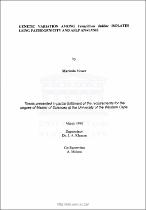| dc.description.abstract | Soilborne plant pathogenic fungi have had an important economic and social impact on humans since the evolution of agricultural societies (Stakman, 1959). In South Africa, the soilborne pathogen Verticillium dahliae Kleb, causes wilt and early dying, which results in extensive losses in the production of potatoes and tomatoes (Uys et al., 1995). Control of soilborne diseases however remains elusive. Since roots are hidden from view, disease development and subsequent yield loss are not recognised until harvest or when symptom expression, in the form of plant death, occurs, by which time it is too late to react with any control measure. Management of soil-borne diseases is a continual challenge to growers. The structural, physical, and biological complexity of the soil environment, in which pathogens interact with plant roots, inherently limits the options available for disease control. The oldest and most fundamental approach employed by man to control plant diseases is the modification of cultural practices. Most cultural practices used to control plant diseases are preventative in nature. Some of the most proven control measures remain resistance and, in some situations, fungicides. Despite efforts to effectively combine these options with other control strategies, soilborne diseases continue to constrain crop production (Ligoxigakis & Vakalounakis 1992). Therefore, the study of soilborne diseases and their control poses a continuing challenge for plant pathologist. | en_US |

